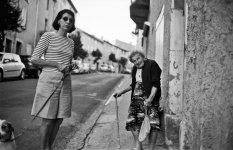hepcat
Former PH, USN
But, how about the fact that an SLR shows you exactly how it'll look perspective wise and a RF does not... i.e. the rangefinder is not showing you what the lens sees. This adds a little bit of chance into framing no? It could offer suprises that lead to creativity.
Hmm... parallax is a fact of life with a rangefinder camera. It's also a fact of life with twin-lens reflex cameras. With experience, you learn how to work with it. That's one of the major differences between the genres. There are folks who just can't do bright-line finder cameras. They never come to grips with how to use that kind of finder to their advantage.
I think that understanding perspective control with a bright-line finder camera is a different process than with an SLR, but I don't think it's any less precise or accurate.





